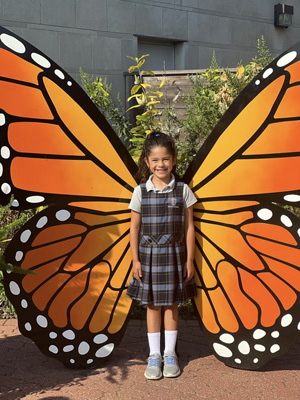
Authors: 2nd Grade Students of Principia School
Dear Reader,
This fall our second grade class at Principia School noticed there weren’t a lot of Monarch butterflies in the native plant garden on our playground. We wanted to find out why so we did some research. We learned there was a drought last year in Texas. Did you know Monarch caterpillars can only eat milkweed plants? We learned this is called a symbiotic relationship because the Monarch must have the milkweed to help their eggs survive. The Monarch helps the milkweed by pollinating its flowers. Because of the drought, the milkweed in Texas didn’t survive and the Monarch butterflies that fly through Texas didn’t have anywhere to lay their eggs. The caterpillars didn’t have any food. Monarchs start as an egg. Then they hatch into larva or a caterpillar. The caterpillar turns into a chrysalis and then becomes a butterfly.
We did a video call with an expert from the organization Monarch Watch. We learned lots of facts. We can see the difference between a male and female, by looking for a little dot on the hindwing. The male has the dot. The amount of sunshine and the temperature are factors in how soon an egg hatches. Monarchs migrate to the oyamel fir forests in Mexico every year. It takes four generations of Monarchs each year to make the migration. First, the butterflies travel from Mexico to the United States, then each generation flies a little bit more north. Finally, the great-great grandchildren do the super migration flying back south to Mexico.
Monarchs aren’t finding much Milkweed, so that is why we need to plant more Milkweed. In our class, we made “Seed Spheres” and taught other people how to do it too. Let us tell you how to make them:
- Step 1: Get some muddy soil, and roll it into a ball the size of a penny.
- Step 2: Get 2 Milkweed seeds.
- Step 3: Squish them into the ball and roll it up again.
- Step 4: Throw it out in your backyard. The seeds will plant themselves.
If you want to learn more about Monarchs and Milkweed you can visit the Sophia M. Sachs Butterfly House in Chesterfield, Missouri, read the book Milkweed For Monarchs by Christine Van Zandt, or visit the websites www.monarchwatch.org, www.journeynorth.org, and www.grownative.org/learn/natives-for-monarchs/.
Thank you for helping the Monarchs!
Sincerely,
Principia School, 2nd Grade Class


